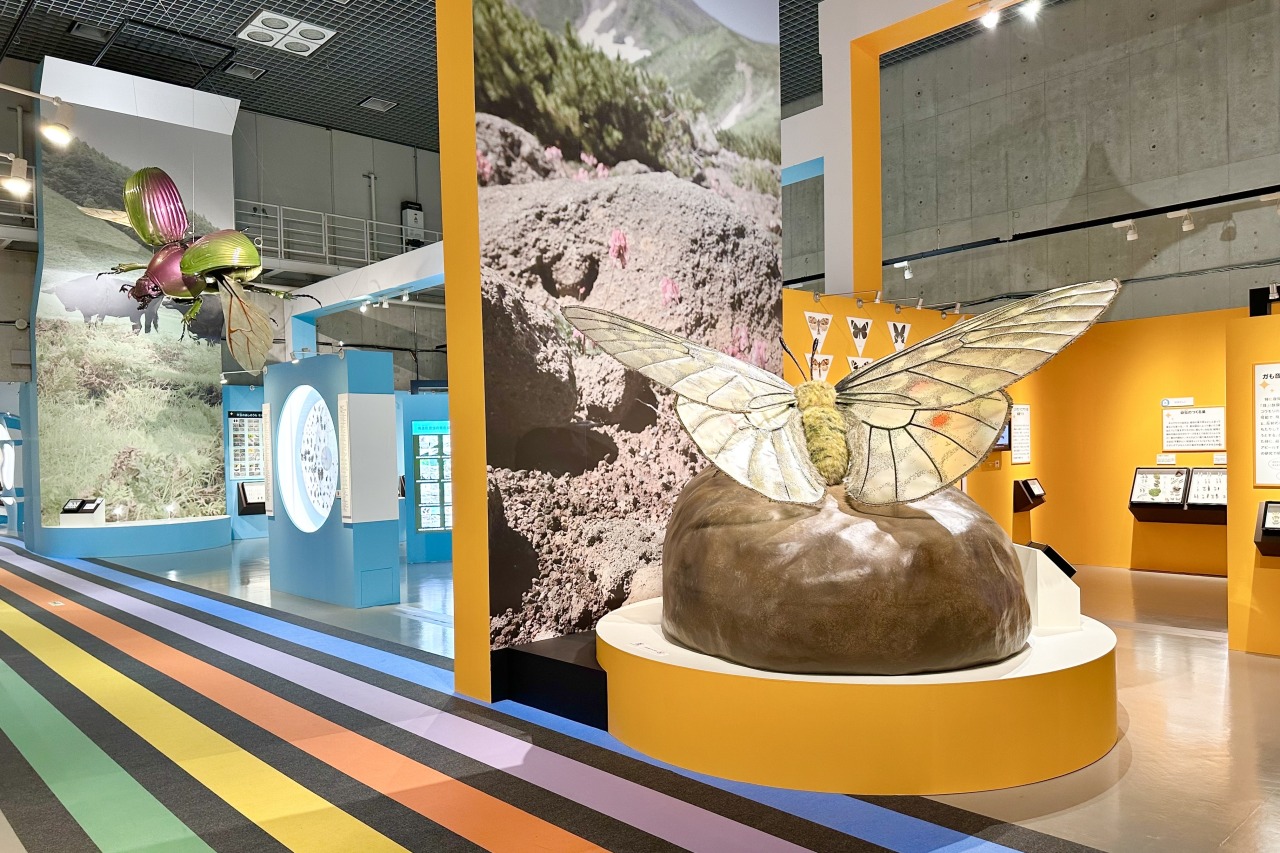
Article provided by: Taito Cultural Marche
Insects are the largest group of living organisms on Earth, accounting for more than half of all reported species. A special exhibition called “Insect MANIAC” has opened at the National Museum of Nature and Science, delving into this unknown world from a variety of unique perspectives. The exhibition will run until Monday, October 14, 2024 (national holiday).
*The contents of this article are current as of the date of coverage (July 12, 2024). For the latest information, please check the official exhibition website.
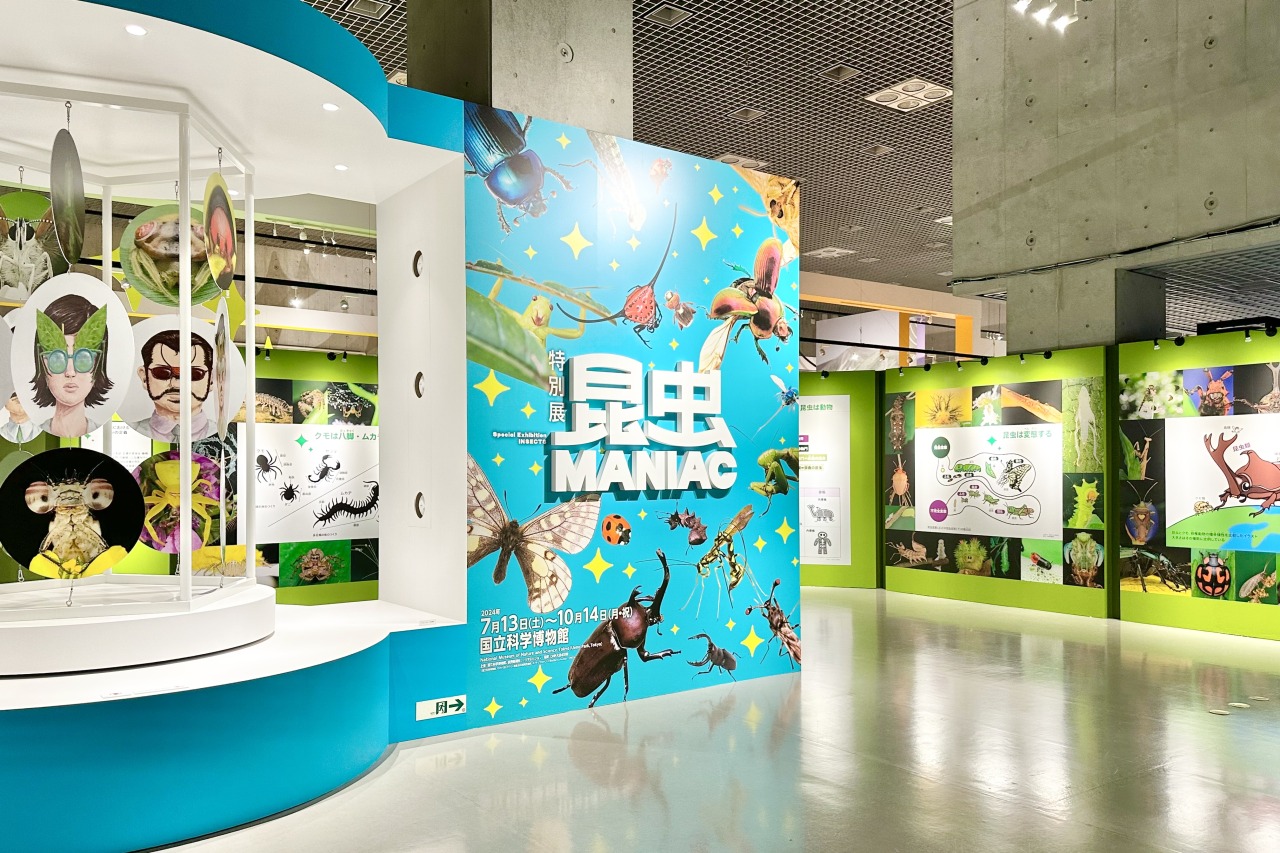
entrance
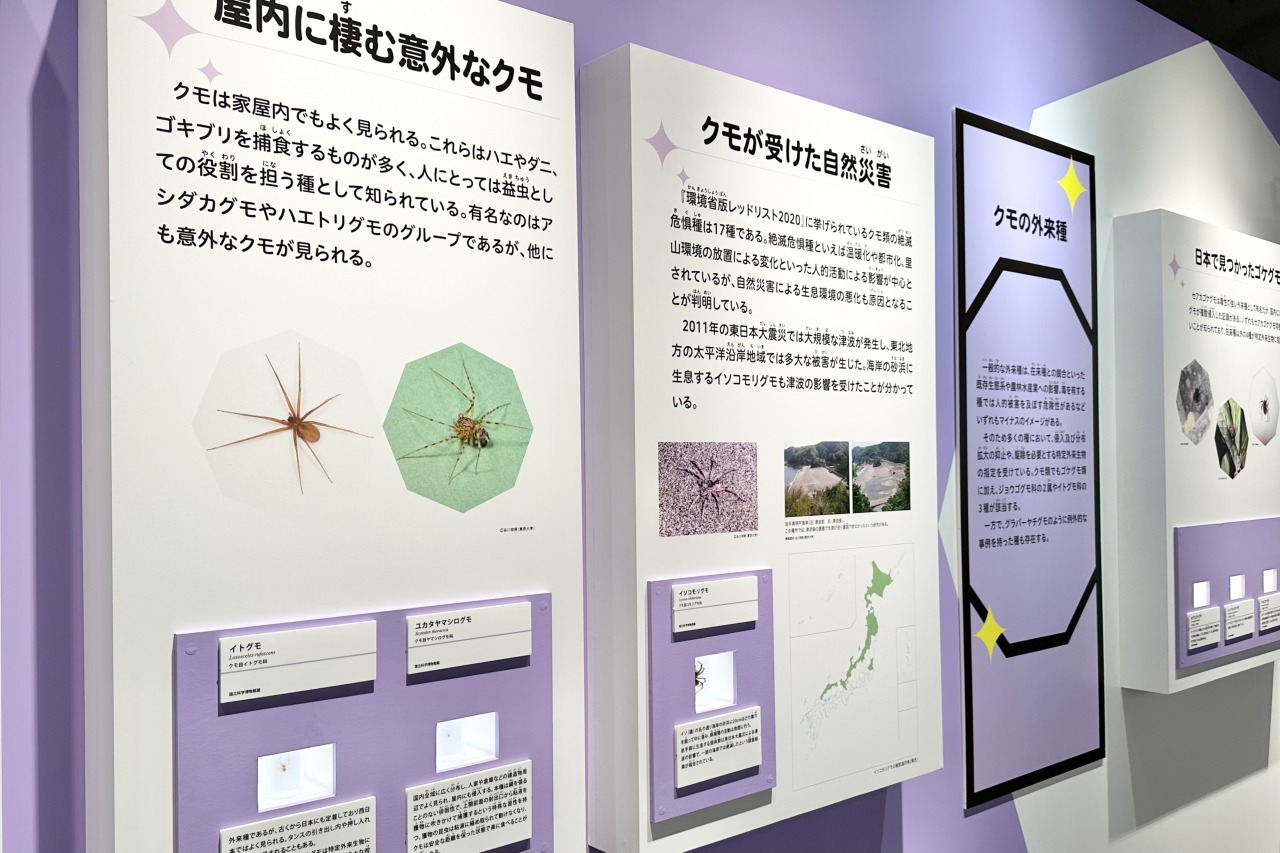
Exhibition view

Exhibition view
There are approximately one million species of insects that have been named by humans. Although they are the wild animals that live closest to humans, only a handful of species are generally recognized. Furthermore, even for insects whose names are known to everyone, there are many cases where their ecology is shrouded in mystery, or where they hide interesting secrets that only researchers know.
This exhibition features a wide range of insects, from giant beetles over 10 cm long to tiny bees less than 1 mm long, and even spiders, centipedes, and other terrestrial arthropods that are also called “mushi” (insects). Five researchers from the National Museum of Nature and Science interweave precious specimens and the latest insect research to delve deeply into the overwhelming diversity of insects, one step beyond the knowledge you can get from books and illustrated guides.
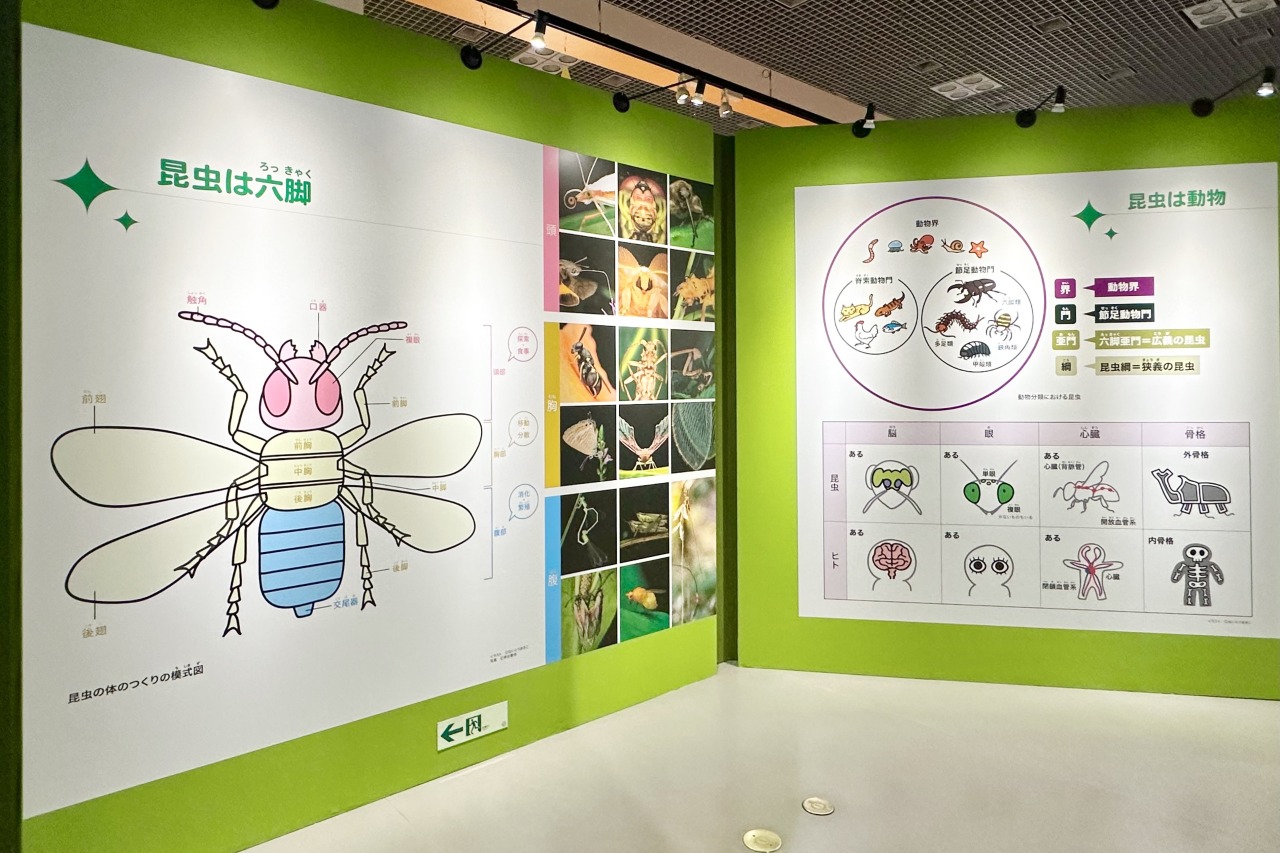
Exhibition view of “Zone 1: Insects and Bugs”
Although it is a niche subject, the venue has set up an introductory section called “Zone 1: Insects and Bugs” where basic information such as the differences between insects and bugs and their characteristics is reviewed, so even those who are not familiar with insects need not worry.
The next section, “Zone 2: Diverse Insects,” is the main section of the exhibition. It is divided into five doors according to the researchers’ specialties. The “Dragonfly Door” introduces incomplete metamorphosis insects such as dragonflies, grasshoppers, and cicadas, the “Bee Door” introduces bees and flies with membranous wings, the “Butterfly Door” introduces butterflies and moths, the “Rhinoceros Beetle Door” introduces beetles such as rhinoceros beetles and stag beetles, and the “Spider Door” introduces the world of arthropods other than insects, such as spiders, centipedes, and scorpions. Each door deals with content related to three keywords: “The key to diversification,” “New common knowledge about insects,” and “Food, clothing, and shelter for insects.”
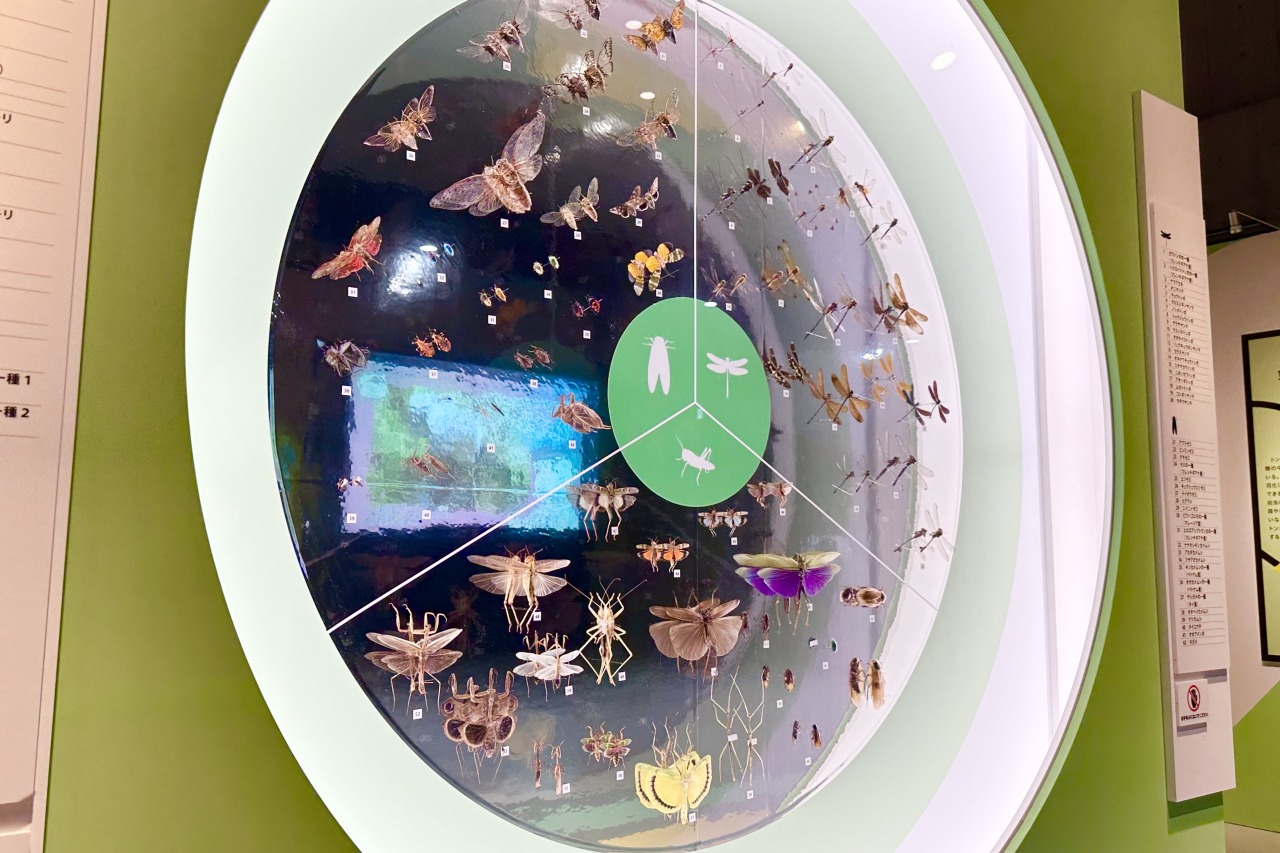
“Zone 2: Diverse Insects” exhibition view. The insect specimens displayed at each door are also a highlight.
Five giant models, each of which was carefully designed by researchers with great attention to detail, await visitors as landmarks in each area.
It’s a little different from a typical insect exhibition. For example, the model of the Ezo longhornet does not show a cool flight, but rather reproduces the indescribable appearance of the insect deforming its body to lay eggs. The surprise of “That’s what you’re paying attention to!?” is also one of the best parts of this exhibition.

A giant model of a giant wasp
As someone who is not very knowledgeable about insects, this exhibition was full of surprises.
For example, the societies formed by insects. The familiar ecology of hornets and honeybees, where worker bees and queen bees live in groups and divide up the tasks of labor and egg-laying, is rather rare in the Hymenoptera order, which has about 150,000 species, and there are overwhelmingly more solitary bees. This is a low level of knowledge in terms of mania, but I was shocked because I had the fixed idea that “bees are insects that live in groups.”

Exhibition on insect society
In addition to the “eusocial” ecology of bees, in which they live in groups, there are various other ecologies, such as “solitation,” in which bees basically live alone after the mother bee leaves after laying eggs, “subsociality,” in which the mother bee feeds the hatched larvae even after laying eggs, and “worker parasitism,” in which bees depend on other bees to build nests and gather food. For this reason, bees are said to be of great interest as research material for considering the evolution of sociality in insects.
The exhibit on gender diversity was packed with some pretty nerdy stuff, but one thing that caught my eye was a unique “ginandromorph” (hermaphrodite) specimen that has both male and female characteristics.
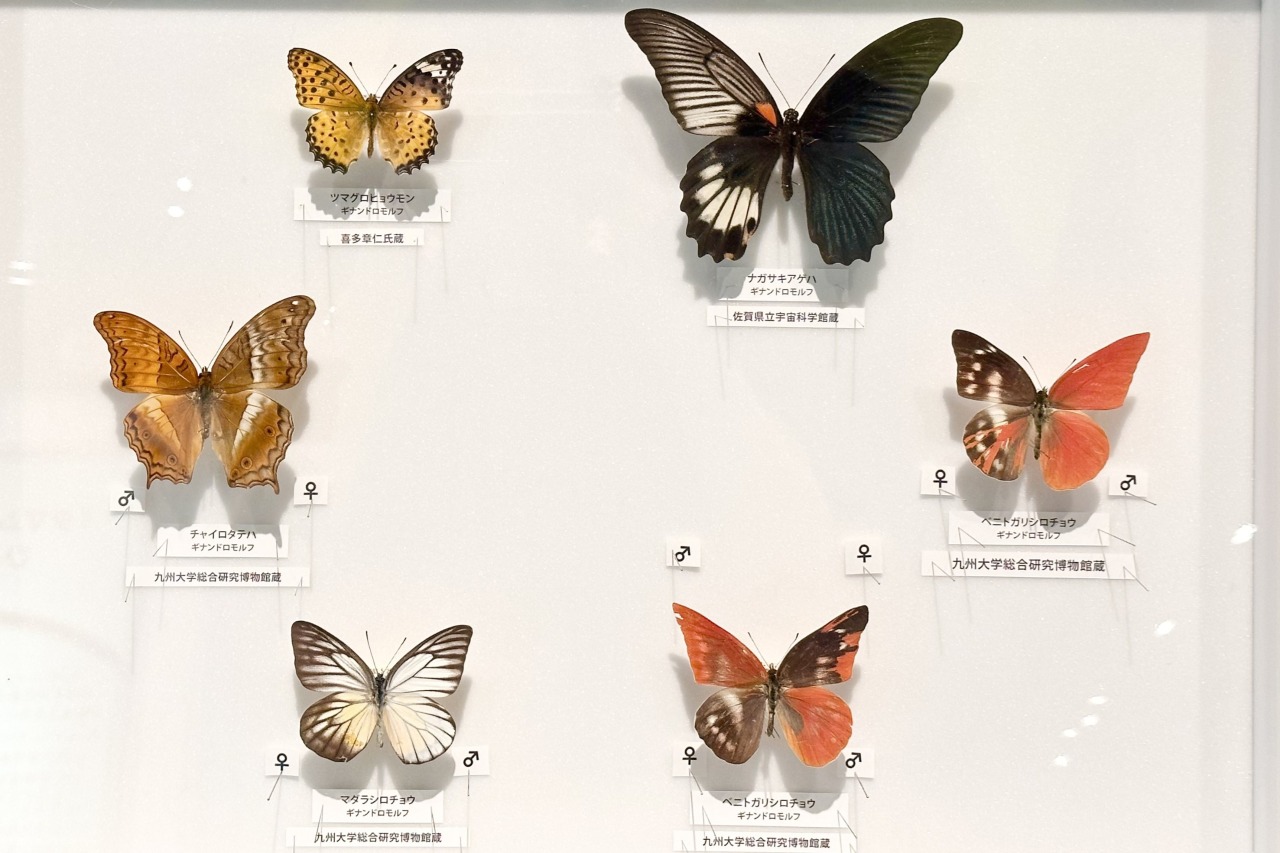
A specimen of a ginandromorph butterfly. The red-spotted pearl sphagnum var. nigricans in the lower right shows the characteristics of both sexes diagonally.
Among many individuals of the same species, ginandromorphs can occasionally occur, and in the case of butterflies in particular, many examples have been found in which the butterfly is clearly divided into left and right wings along the center line. The exhibit also features an even rarer ginandromorph specimen in which the left forewing and right hindwing are male characteristics, and the right forewing and left hindwing are female characteristics. The symmetry of each butterfly is beautiful, and one cannot help but feel the mystery of life.
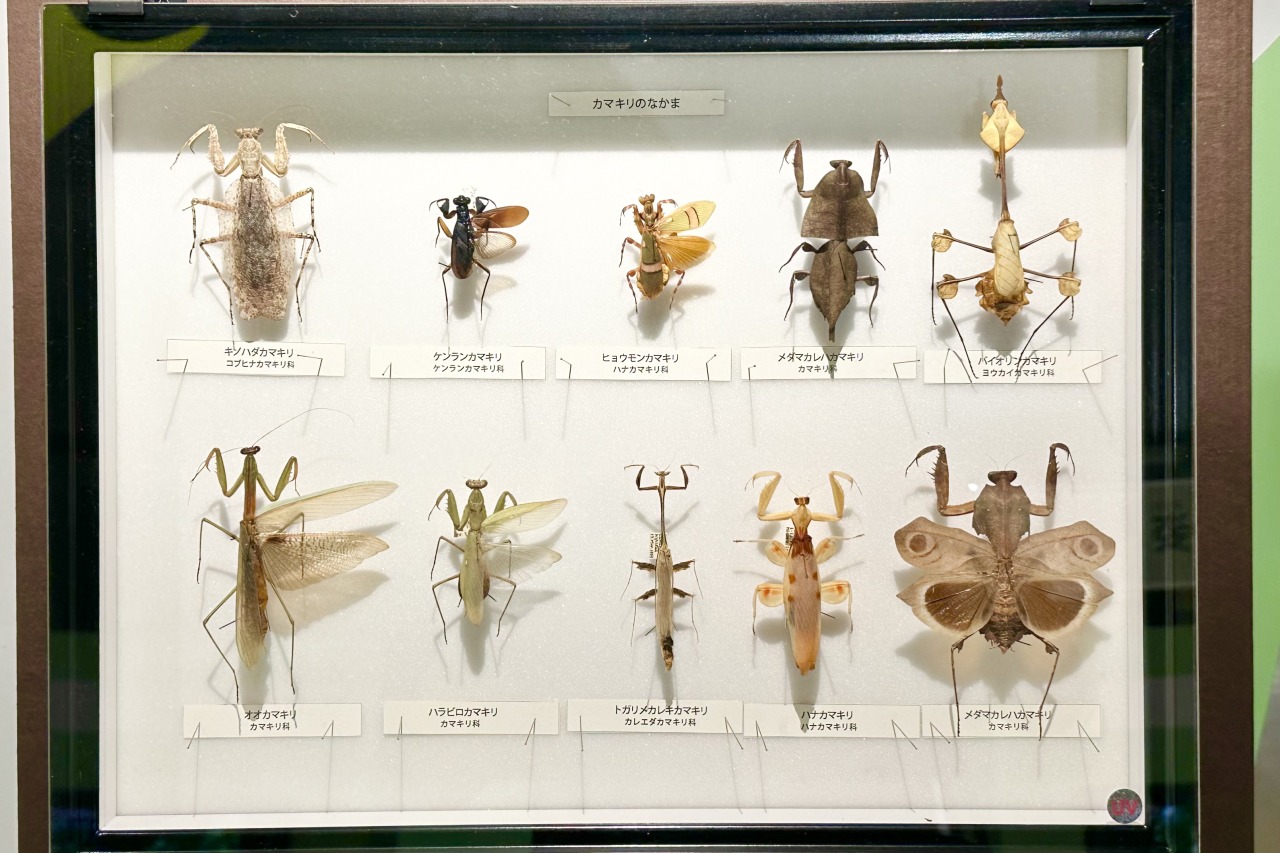
A specimen of a praying mantis that camouflages itself as a dead branch or fallen leaf. The violin mantis on the top right has a particularly unique form, and at first glance it doesn’t look like a living thing.
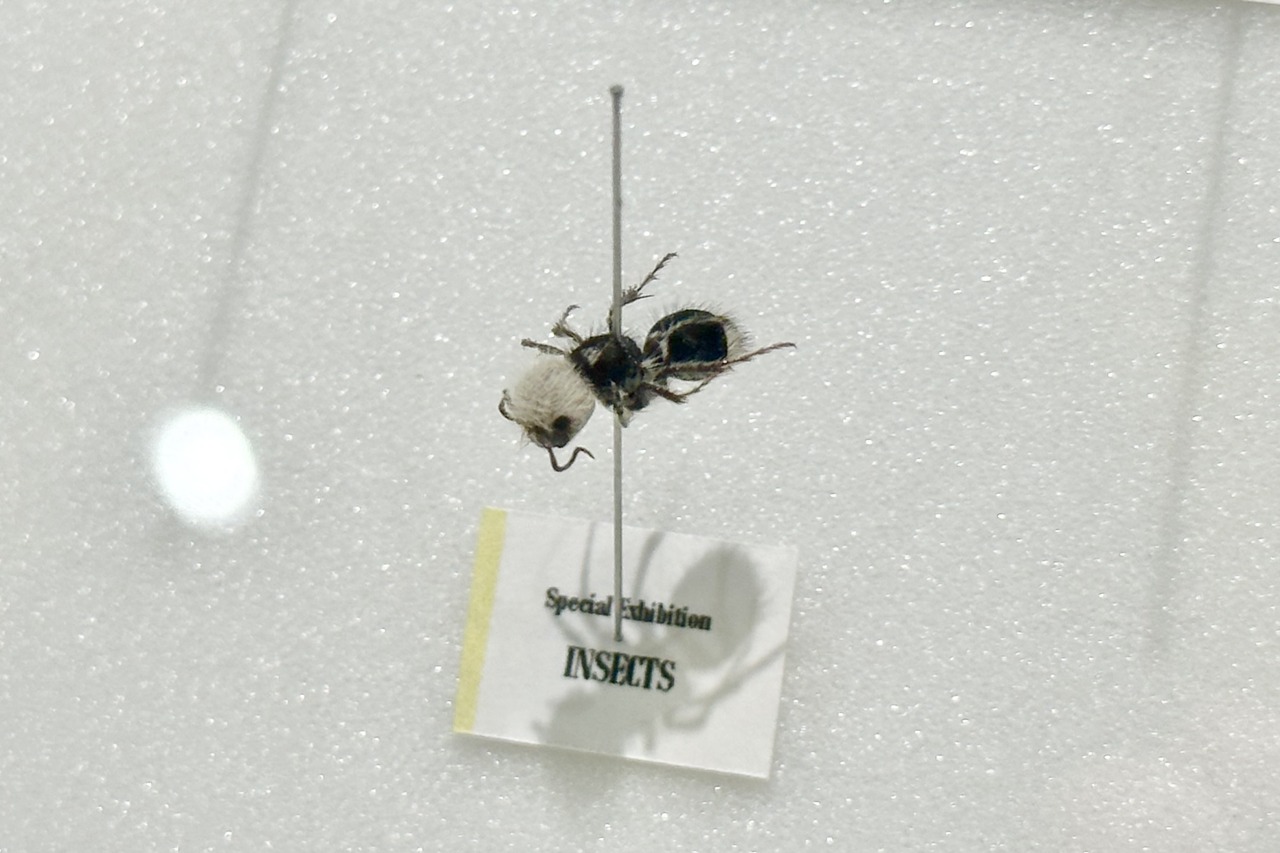
A specimen of the panda ant that lives in South America. The confusing thing is that it’s neither a panda nor an ant, but actually a bee.
At the venue, you can not only observe the complex, strange, and beautiful visuals of insects as they are, sometimes even under a microscope, but you can also enjoy elaborately presented specimens that are not just displayed in a monotonous manner.

Beetle and stag beetle specimens of various sizes
For example, different sized rhinoceros beetles and stag beetles are arranged in a gradational circle to create a stylish piece of art, or a single different species of butterfly is mixed in with a row of the same butterfly to create a spot the difference game. The arrangements are well-balanced to entertain visitors.
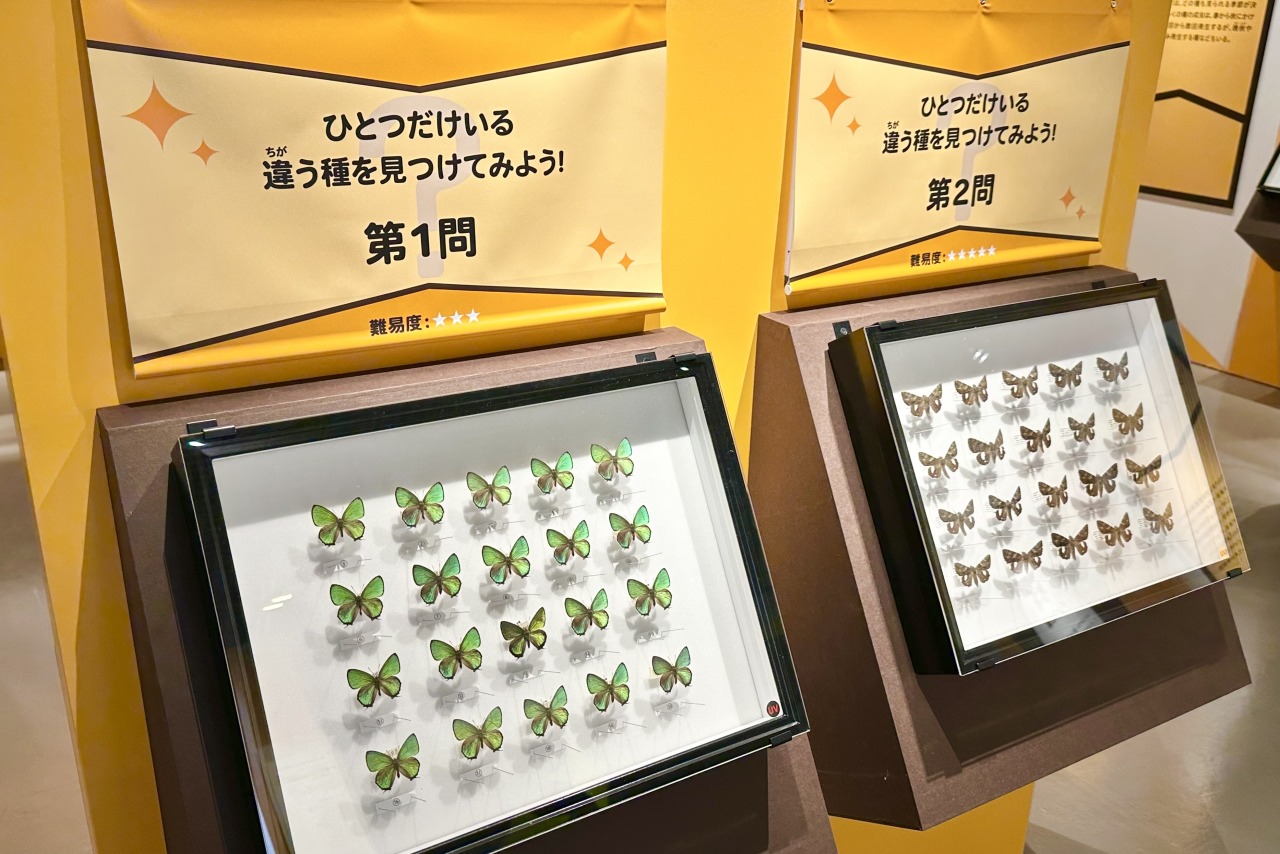
This is a quiz where you have to guess the species that is mixed in with the only other animal. It’s quite difficult.
The specimens of insects with “structural colors” such as the iridescent color of the Japanese jewel beetle, which are produced not by pigments but by the interaction of sunlight with fine structures, looked like an unusual jewelry box. The gemstone weevil, which lives around New Guinea and has structural colors on its body surface called phoronic crystals, was extremely beautiful, shining brilliantly in green, blue, and purple depending on the angle.

A specimen of the stone weevil
One of the attractions of this exhibition is that it allows visitors to experience the world of insects from various perspectives, not just by “seeing,” but also by “listening,” “touching,” and “smelling.”
In North America, there are two groups of cicadas, the 17th cicada, which emerges every 17 years, and the 13th cicada, which emerges every 13 years, known as “prime cicadas.” Both groups emerge in large numbers at the same time once every 221 years, which is a common multiple of 17 and 13 years, and as was reported in the news in Japan, 2024 was a lucky year.
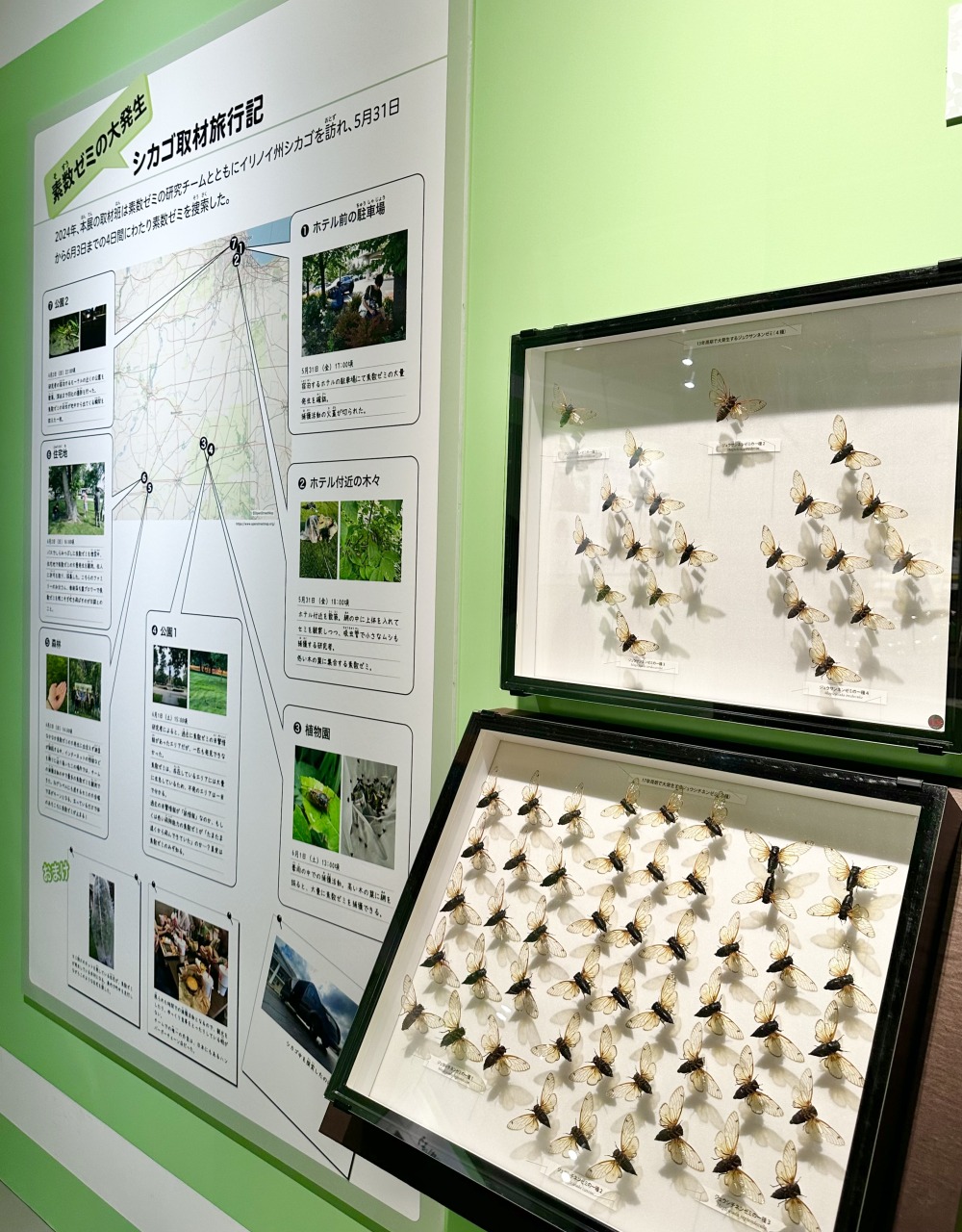
Prime Number Seminar Exhibition
The venue is filled with the sounds of various insects, but one spot in particular that is worth paying attention to as an experiential exhibition that allows you to “listen” is the spot where you can experience the chorus of the Prime Number Seminars. The research team traveled to Chicago, Illinois for this exhibition. The recordings, which reached a maximum of 85-86 decibels (the same level of noise as inside a pachinko parlor), are presented along with a travelogue.
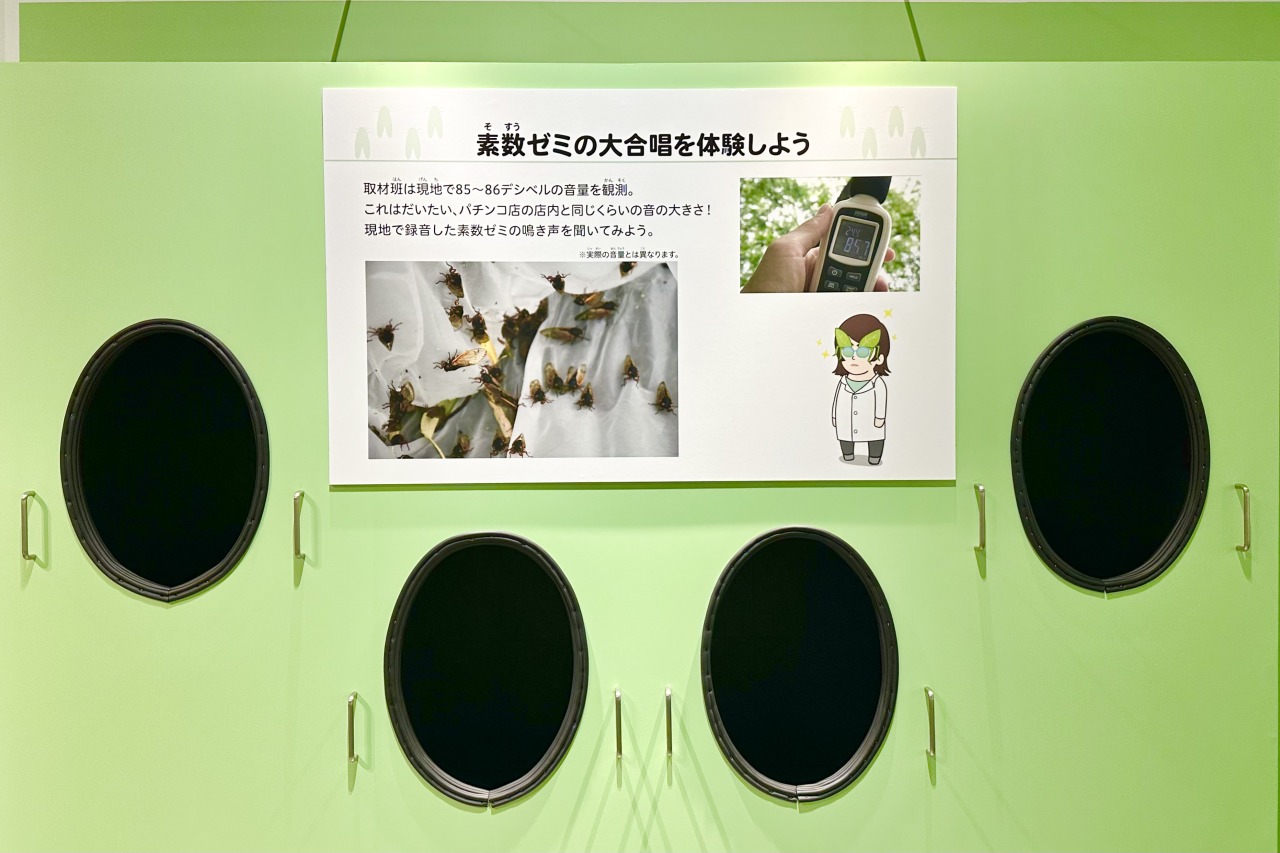
A spot to experience the Prime Number Seminar chorus
As an experiential “smelling” exhibit, there is a spot that sprays out the scent of eucalyptus tallow, which is found in the essential oils of eucalyptus, which is favored by ground wasps, and skatole, which is found in their droppings. Ground wasps live only in Central and South America, and have a unique habit in the world of males collecting the scent components of flowers in order to approach females. Their glossy beauty is also a highlight.

Exhibition of wasps
The “touch” experience exhibit allowed visitors to touch real galls, which are nests made by aphid larvae that parasitize plants and create abnormal developments in the plant to protect themselves from predators. Although none of the exhibits were flashy, they were sure to stimulate intellectual curiosity.
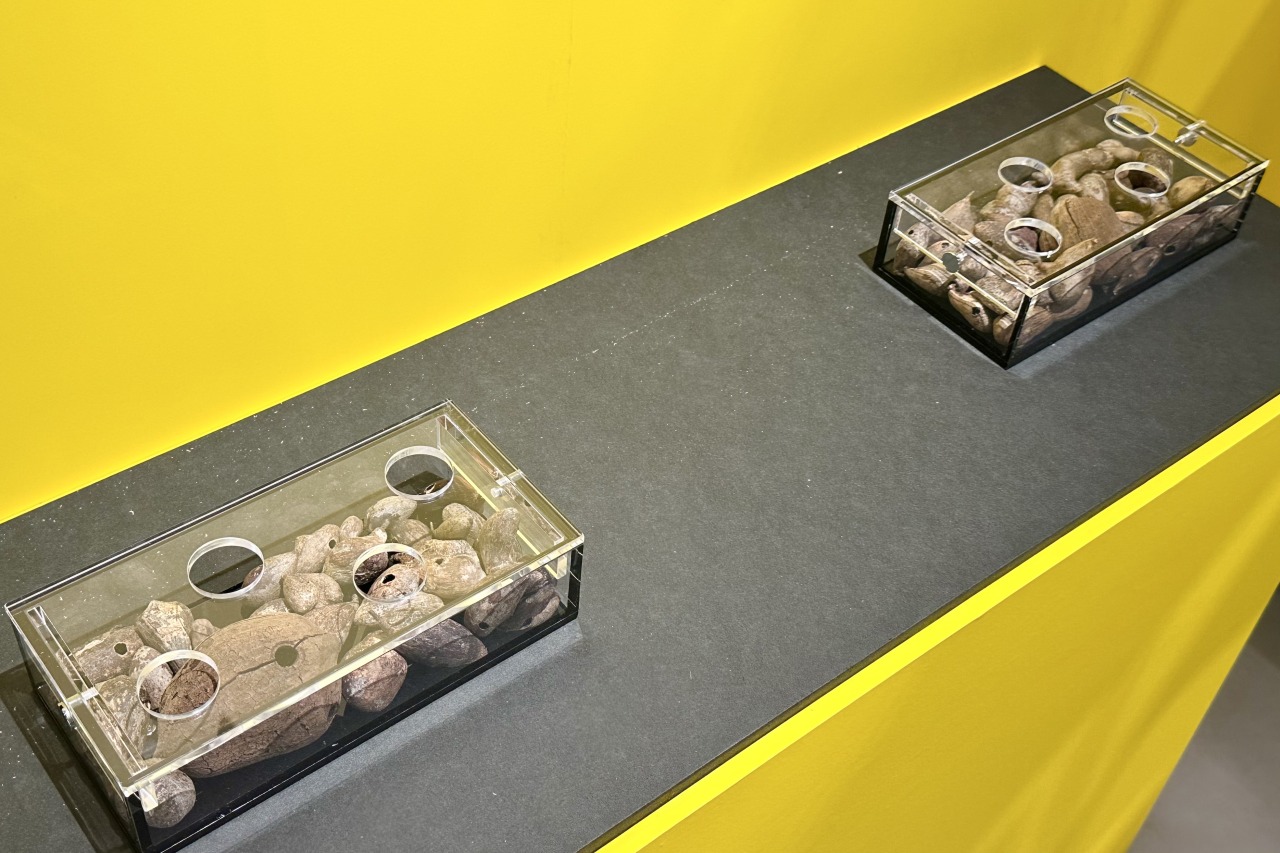
Gall-touching spots

Various gall specimens. The one in the petri dish is a gall from the Jumping Coal Wasp, known as the only “jumping gall” in the world, and the video shows the gall jumping around.
The remaining zone, “Zone 3: Insects and People,” serves as an epilogue, looking into the world of insects that surround us and are part of our everyday lives, and thinking about the future of insects and people.

Exhibition view of “Zone 3: Insects and People”
Depending on a person’s perspective, insects can be considered either pests or beneficial. The exhibit uses hornets as an example of a typical pest, explaining that while they pose a risk of stinging people, they also help to prevent damage caused by insects in farmland. By changing one’s perspective, the exhibit conveys that people’s lives are supported by an ecosystem made up of a diverse range of organisms.
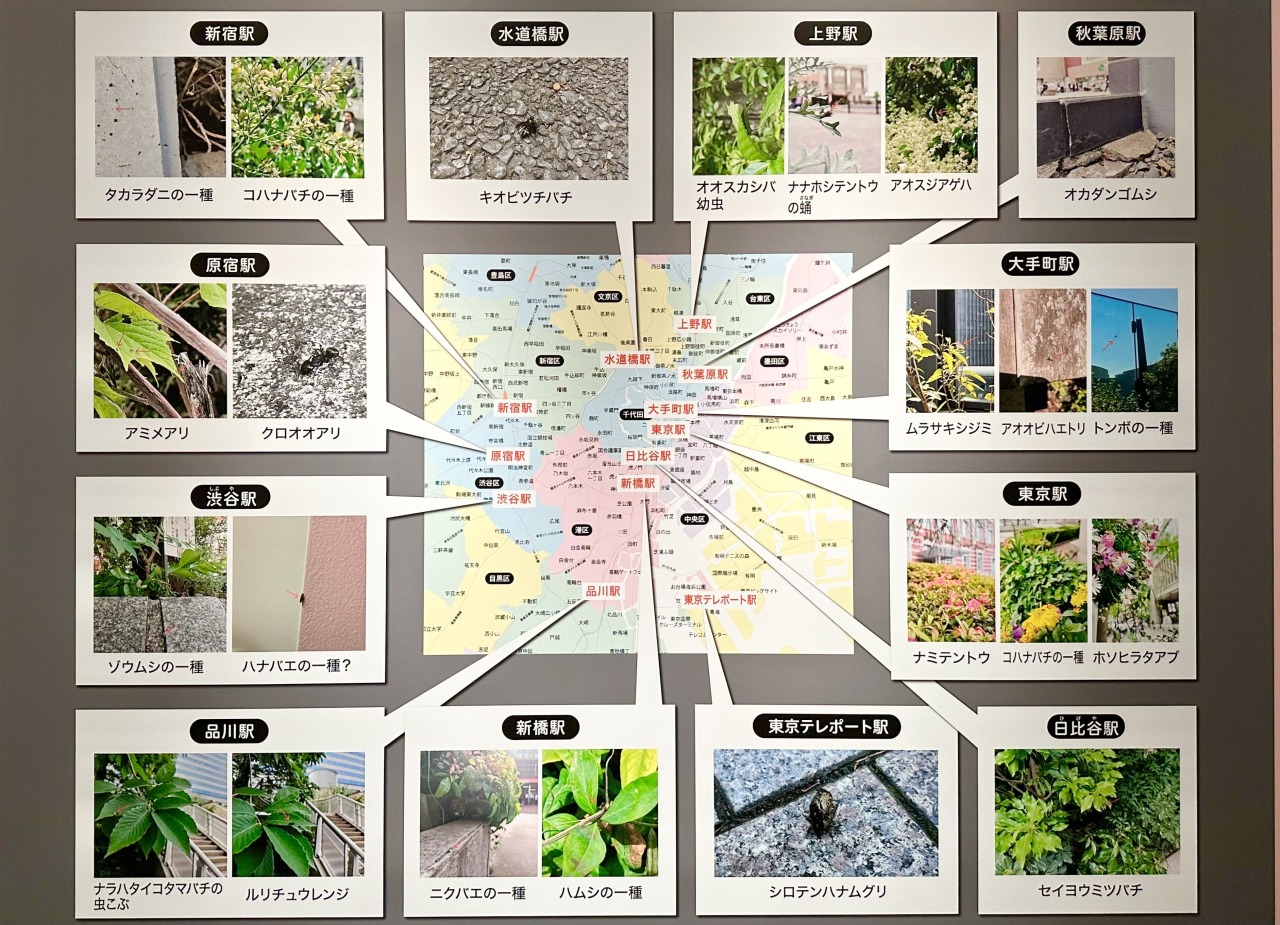
A map of insects living in the city
At first glance, insects seem to live robustly even in cities where there is little natural environment left, and even inside homes, which can be a big deal for people who dislike insects. Interestingly, there is a hypothesis that even if people see the same insect, they feel more psychological disgust when they see it inside the house than outside. Furthermore, it is possible that the fact that urbanization has reduced the opportunities to see insects on a daily basis is the reason why people dislike insects as “mysterious things.”
Therefore, the caption of the epilogue also included an advice-like statement: “By learning about each individual bug and why you don’t like them, you may be able to ease your aversion to all bugs a little.”

Exhibits of insects whose populations are declining due to changes in the global environment, such as the endangered Ishigaki Niini
The exhibition made visitors think naturally about the tiny world of insects, most of which are unnoticed by humans, yet they are inseparable from our lives and are our closest neighbors.
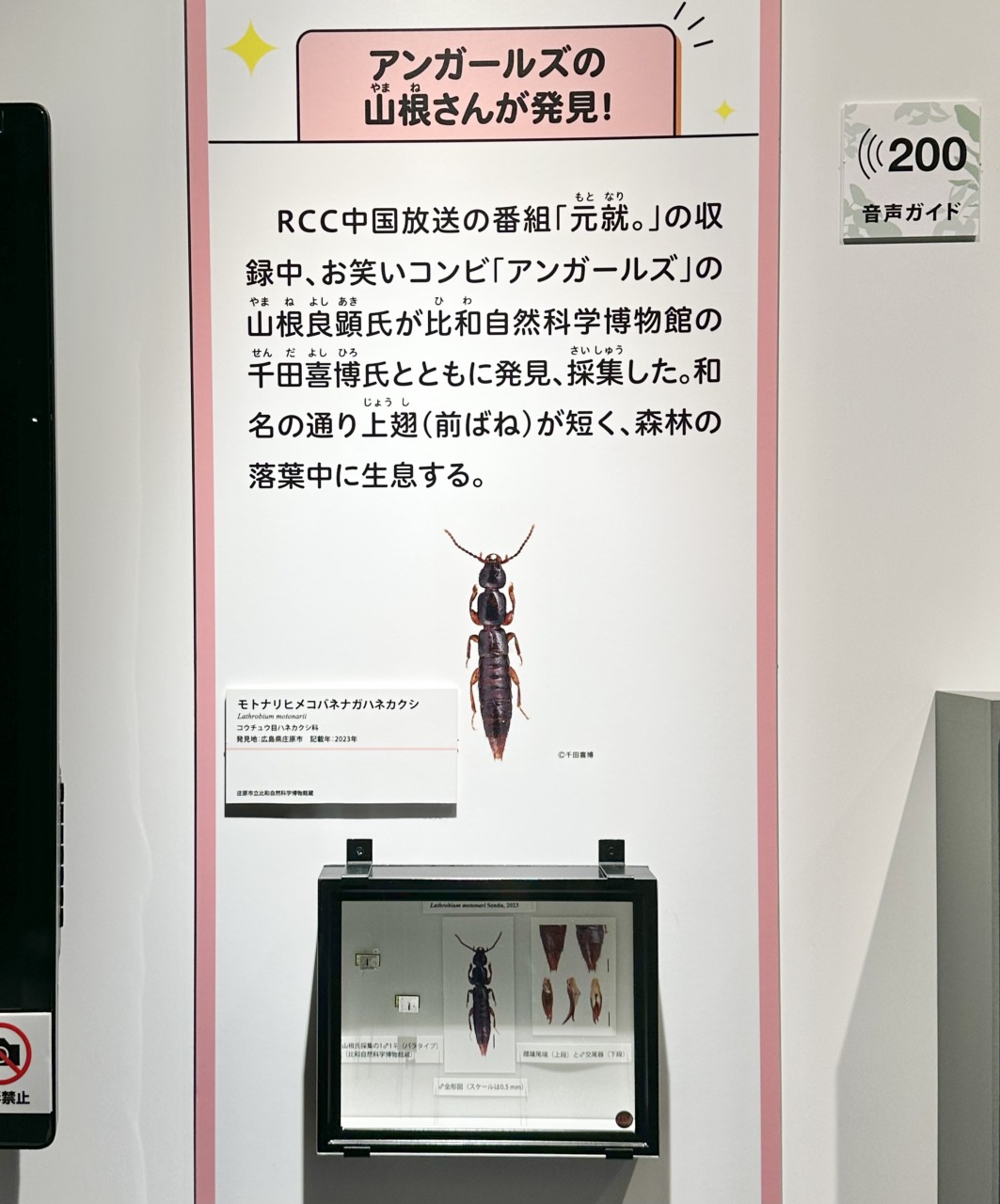
Display of the Motonari small-winged long-horned beetle
In addition, this exhibition will also feature a specimen of the Motonarihimekobaenagakushi, a new species of insect discovered by Yoshiaki Yamane of the comedy duo “Ungirls” while recording a program called “Motonari.” in the mountains of Hiroshima in 2023.
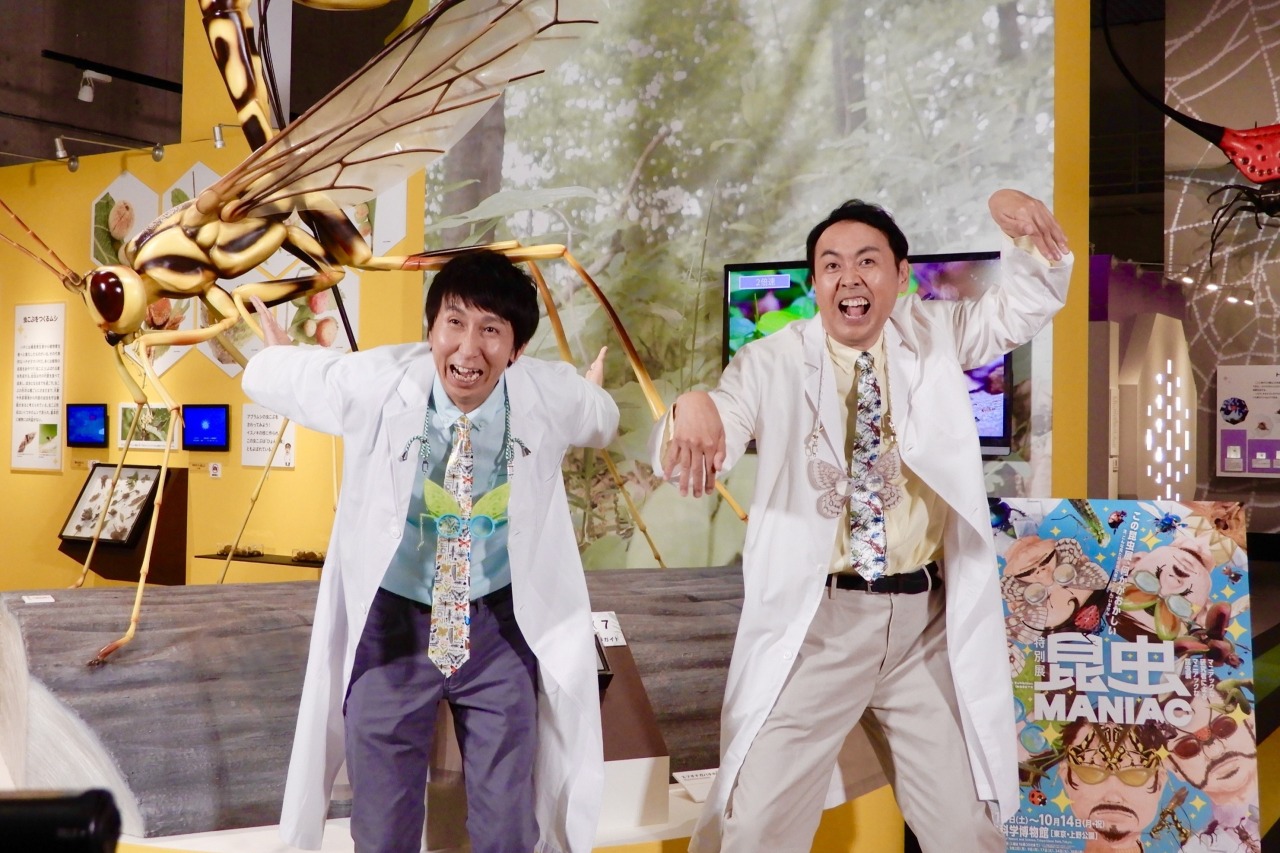
Ungirls’ Yoshiaki Yamane (left) and Takashi Tanaka (right)
As a result of this discovery, Ungirls became the official supporters of this exhibition. Yamane, who appeared at the opening talk held prior to the opening, recalled that when the new species was discovered, Yoshihiro Senda, a researcher at the Hiwa Natural Science Museum who accompanied him, pointed out to him that “this is rare,” but Yamane didn’t take it seriously, thinking it was just flattery for television.
His partner, Takuji Tanaka, continued, “Yamane wanted to finish the location early, so instead of going deep into the mountain, he quickly scooped up some suitable soil near the entrance and found the new species. On the other hand, that was a place that the teacher would not look for.” He laughed and analyzed that the reason for the new species discovery was Yamane’s “sloppiness.”
It seems that new species of insects are surprisingly close to us, but we just don’t notice them. At the end of the exhibition, researchers are introduced to the perspectives, techniques, and tools they use to search for insects, so it might be interesting for students to try discovering a new species of insect as their summer vacation independent study.
The special exhibition “Insect MANIAC” will be held until Monday, October 14th (national holiday).
Overview of the special exhibition “Insects MANIAC”
| Dates | July 13, 2024 (Sat) – October 14, 2024 (Monday/Holiday) |
| venue | National Museum of Nature and Science (Ueno Park, Tokyo) |
| Opening hours | 9:00-17:00 (Entry until 16:30) *However, opening hours will be extended until 7:00 p.m. every Saturday and from August 11th (Sun) to 15th (Thu) (entrance until 6:30 p.m.) |
| Closed Days | September 2nd (Monday), 9th (Monday), 17th (Tuesday), 24th (Tuesday), 30th (Monday) |
| Admission fee (tax included) | Adults and university students: 2,100 yen; elementary, middle and high school students: 600 yen*Free for preschool children. * Free for those with a disability certificate and one caregiver. *For further details, please check the official website. |
| Organizer | National Museum of Nature and Science, Yomiuri Shimbun, Fuji Television Network |
| inquiry | 050-5541-8600 (Hello Dial) |
| Exhibition official website | https://www.konchuten.jp/ |
| Supervisor | Tatsuya Ide [General Supervisor, Wasps] / Researcher, Terrestrial Invertebrate Research Group, Animal Research Department, National Museum of Nature and Science Shuhei Nomura [Coleoptera] / Group Director, Terrestrial Invertebrate Research Group, Animal Research Department, National Museum of Nature and Science Takeshi Jinbo [Butterflies and Moths] / Principal Researcher, Terrestrial Invertebrate Research Group, Animal Research Department, National Museum of Nature and Science Takuya Kiyo [Odonata] / Principal Researcher, Terrestrial Invertebrate Research Group, Animal Research Department, National Museum of Nature and Science Kenichi Okumura [Arachnida] / Researcher, Terrestrial Invertebrate Research Group, Animal Research Department, National Museum of Nature and Science |


